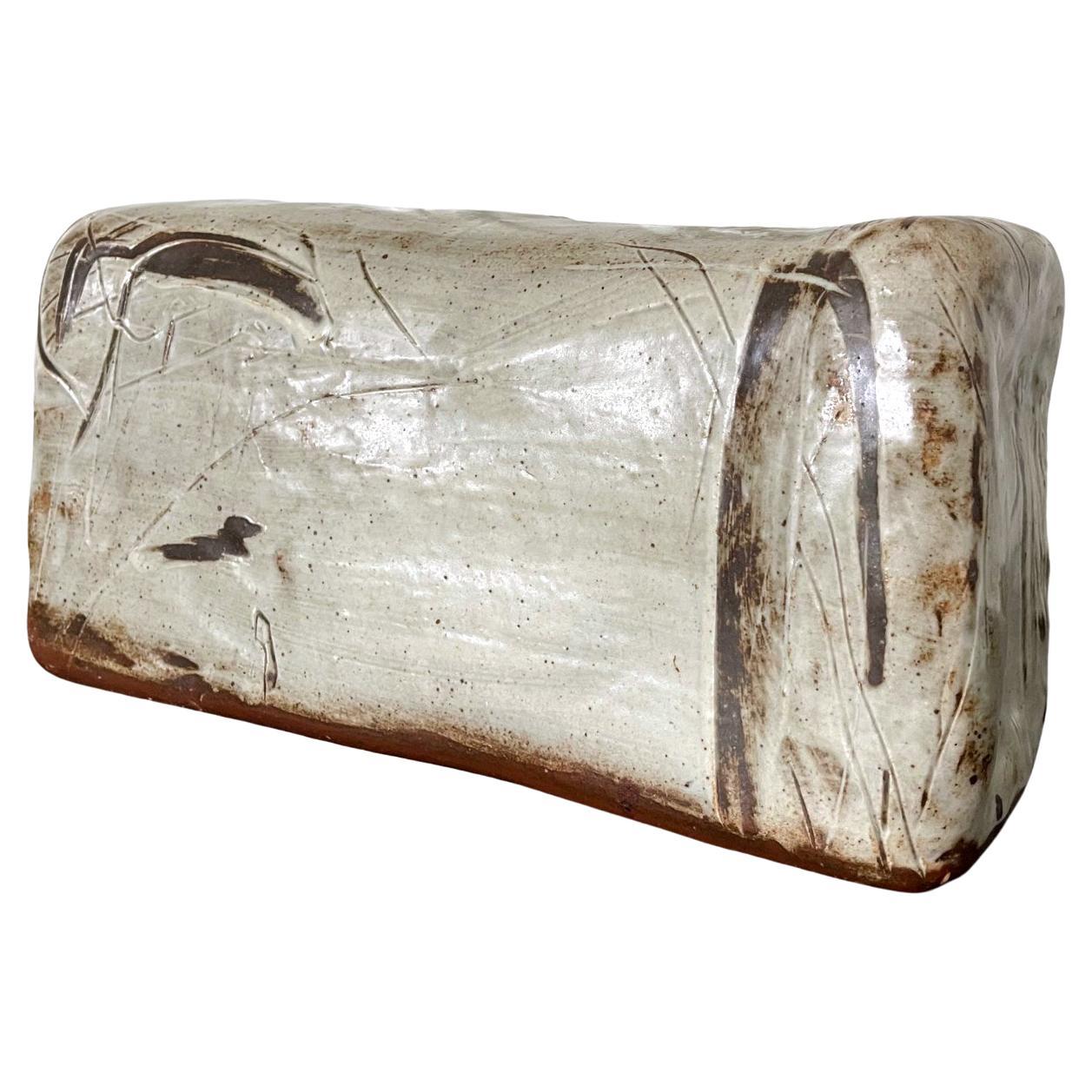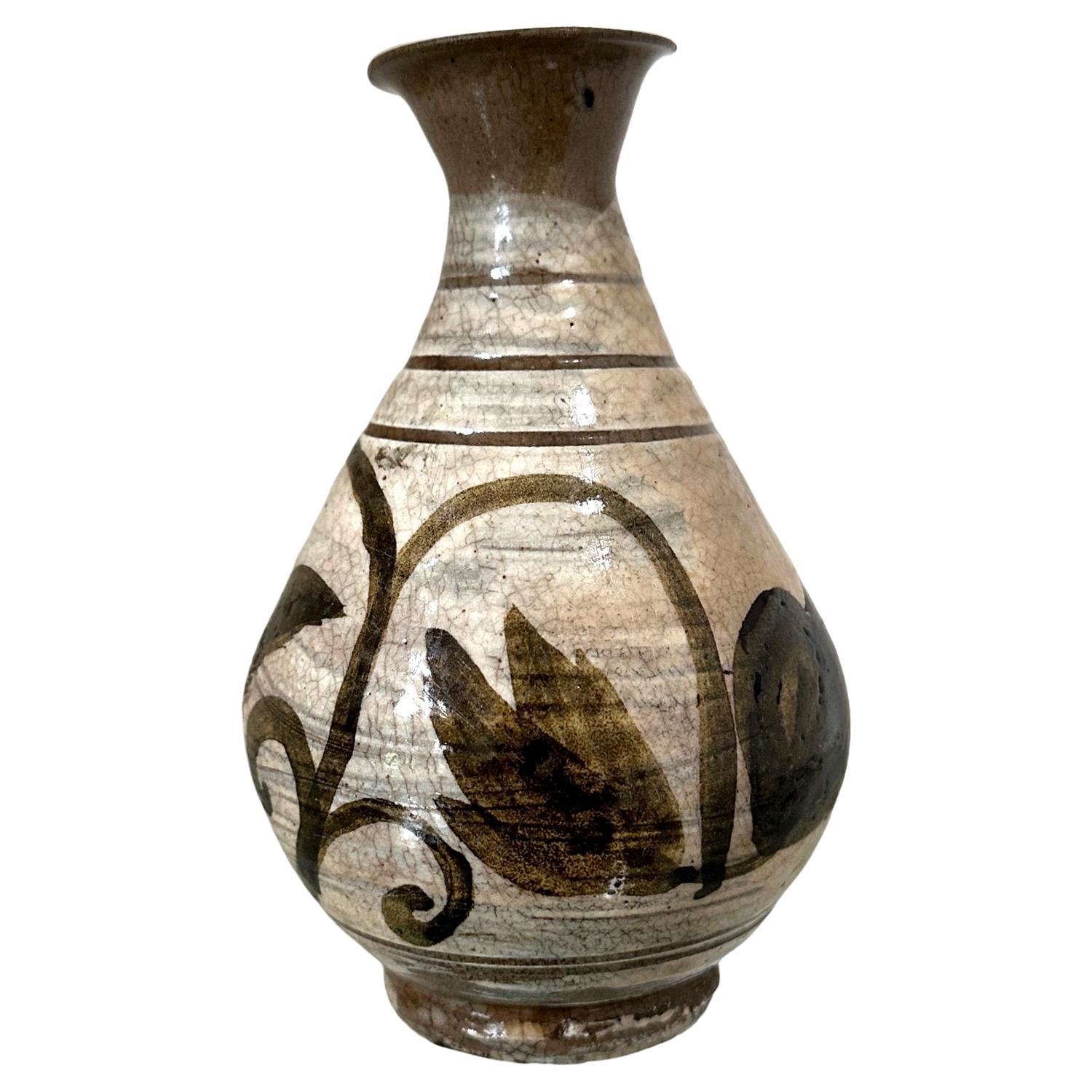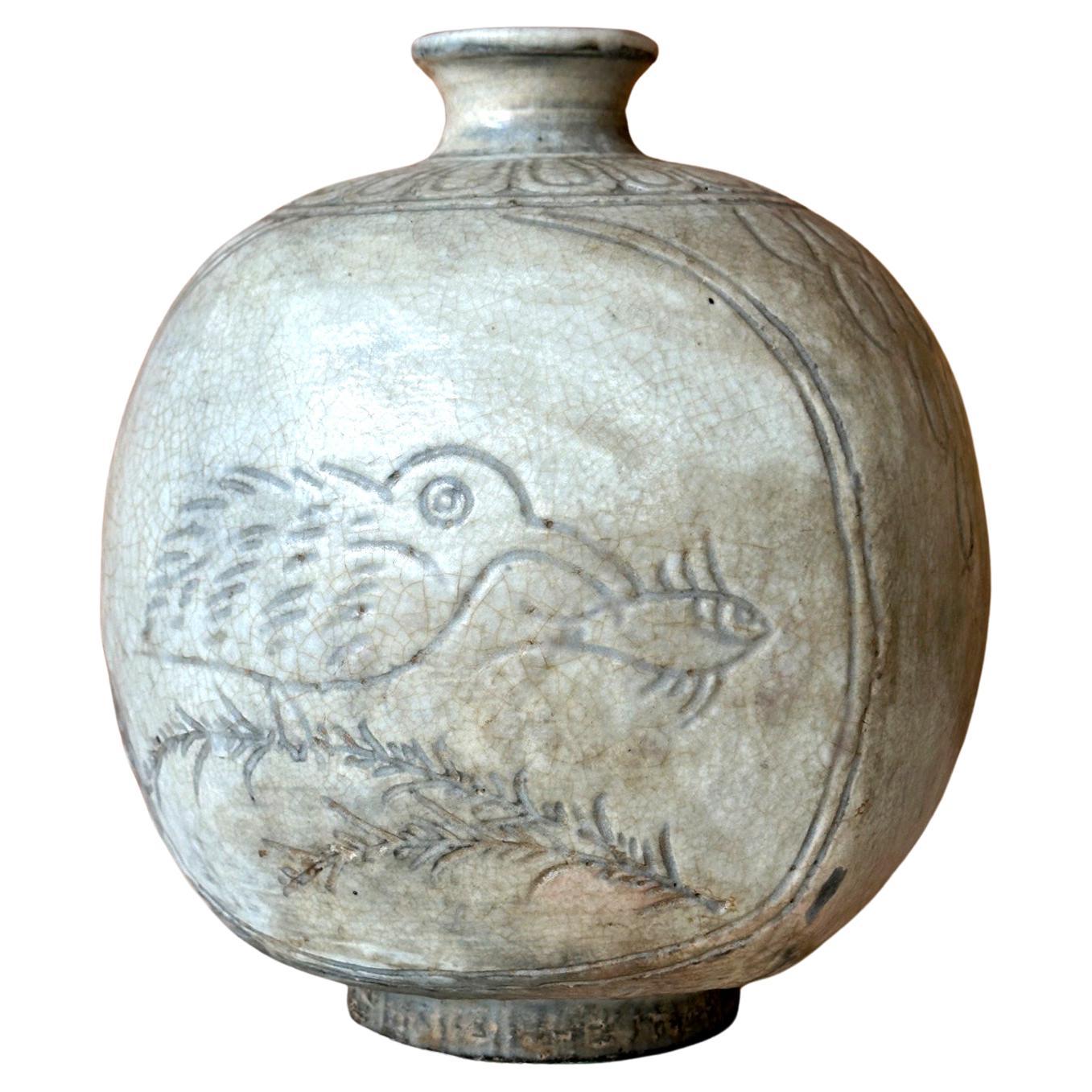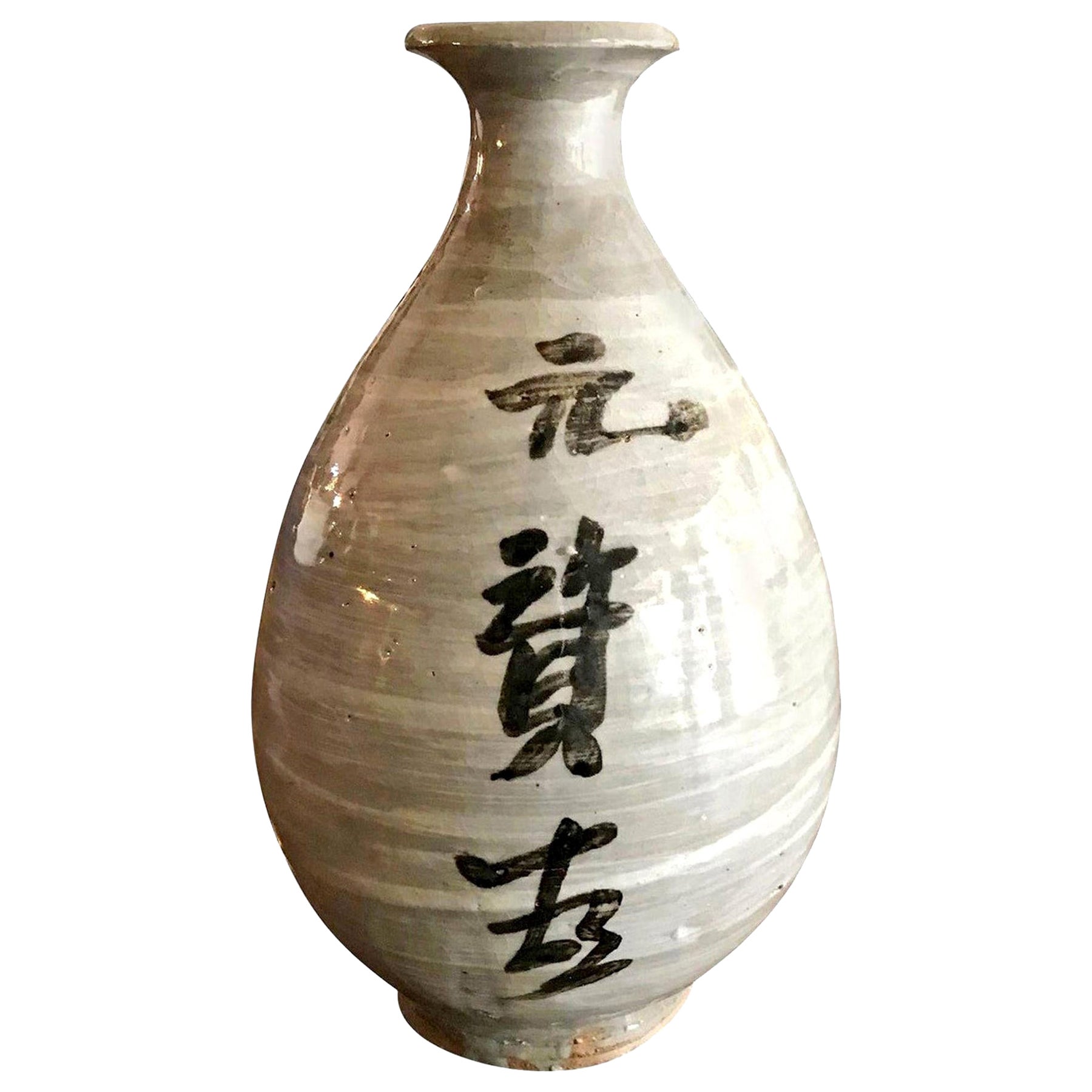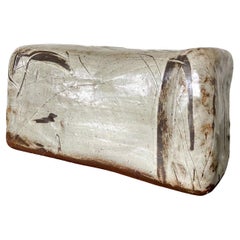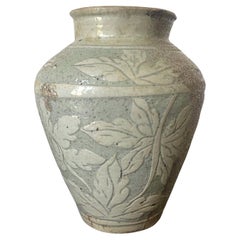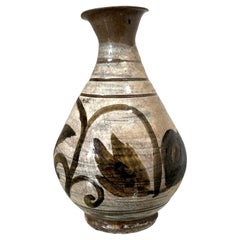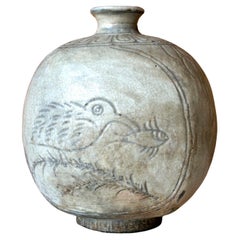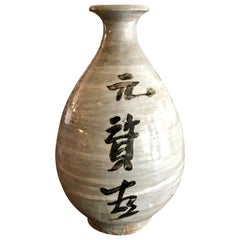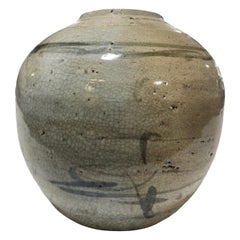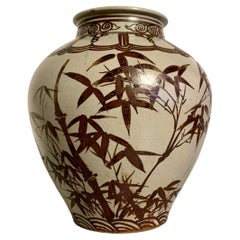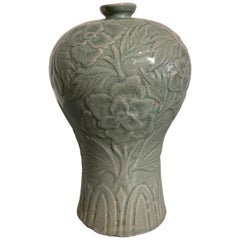Items Similar to Korean Contemporary Buncheong Square Form Vase by Sung Jae Choi
Want more images or videos?
Request additional images or videos from the seller
1 of 17
Korean Contemporary Buncheong Square Form Vase by Sung Jae Choi
About the Item
A ceramic rectangular form vase, part of the artist's "Meditation-Staying" series by South Korean artist Sung-Jae Choi (b. 1962) circa 2000s. The modern vase was heavily potted with a substantial weight that matches its form. It was created in the tradition of Buncheong ware. The surface is covered in a white slip glaze onto which the artist painted a spontaneous aqua scenery with his fingers. With just a few quick strokes, one can easily see ducks floating on the pond with willows swaying and reeds rustling in the wind. The spontaneously decorated surface is also scattered with subtle pinkish spot marks, a characteristic feature called Kase (deer back) found in old Korean export tea bowls called Gohonte to Japan. The piece exudes a folky charm as a modern interpretation of Buncheong ware.
Rooted in ceramic tradition of Buncheong ware circa 14-16th century, Choi revitalized the technique to reach for a modernity that is both refined and rustic, while still retaining a strong sense of poetry and humbleness. The piece is singed on the base as shown and comes with only the lid of its original tomobako storage box (the box itself is missing). The lid is which signed as well as marked with red seals as shown.
Reference: for a similar piece see accession no. FE.57-2008 in the collection of Victoria and Albert Museum. Also 2005.90 in the Art Institute of Chicago.
About the artist: Choi received is BFA and MFA from Hongik Art University in Seoul, Korea in Ceramic Art. He is currently a professor in the Department of Traditional Art and Craft at Korea National University of Cultural Heritage. Choi works in the Buncheong Korean ceramics tradition, showing internationally throughout Korea, Japan, Italy, France, Taiwan, Ireland, and the United States. He has traveled throughout the world via teaching, workshop, and residency positions such as Visiting Professor of Jingdezhen Ceramic University (Jingdezhen, China) in 2015 and Guest Professor of Alfred University (Alfred, NY) in 2006.
Artist's statement: The expression of my Buncheong ceramics is based on that of grayish-blue powdered celadons that were made with white clay and red stoneware clay, which was manufactured in Korea in the 16th century, leading to its maximization of modern pictorial ceramics. This method is focused on applying white slips to the surface of a vessel to maximize its pictorial elements; expression is realized through the process of applying white clay slip to the surface of a vessel with rough brushes, hands or tree branches. As for the shapes, traditionally flat square vessels or round jars are favored. The form and surface aim to express the traces of impromptu passing actions conducted by an artist as well as abstraction and contemplative landscape of a comfortable mind reminiscent of the natural image.
Expression and beauty of Buncheong ceramics are considered to be naturally gained in the process of dealing with materials, and it is hoped that they will have harmonious natural aesthetic sensitivity created through earth, fire, and human beings based on masterful techniques that have been accumulated for a long time without exaggeration or obstinacy.
- Creator:Sung Jae Choi (Artist)
- Dimensions:Height: 13 in (33.02 cm)Width: 9.25 in (23.5 cm)Depth: 4.75 in (12.07 cm)
- Style:Modern (Of the Period)
- Materials and Techniques:Ceramic,Glazed
- Place of Origin:
- Period:
- Date of Manufacture:2000s
- Condition:Wear consistent with age and use. Fine condition with minimal signs of wear. Natural uneven glazed surface intended by the artist.
- Seller Location:Atlanta, GA
- Reference Number:1stDibs: LU945042589962
About the Seller
4.9
Platinum Seller
Premium sellers with a 4.7+ rating and 24-hour response times
Established in 2006
1stDibs seller since 2010
542 sales on 1stDibs
Typical response time: <1 hour
- ShippingRetrieving quote...Shipping from: Atlanta, GA
- Return Policy
Authenticity Guarantee
In the unlikely event there’s an issue with an item’s authenticity, contact us within 1 year for a full refund. DetailsMoney-Back Guarantee
If your item is not as described, is damaged in transit, or does not arrive, contact us within 7 days for a full refund. Details24-Hour Cancellation
You have a 24-hour grace period in which to reconsider your purchase, with no questions asked.Vetted Professional Sellers
Our world-class sellers must adhere to strict standards for service and quality, maintaining the integrity of our listings.Price-Match Guarantee
If you find that a seller listed the same item for a lower price elsewhere, we’ll match it.Trusted Global Delivery
Our best-in-class carrier network provides specialized shipping options worldwide, including custom delivery.More From This Seller
View AllKorean Contemporary Buncheong Ceramic Sculpture by Sung Jae Choi
By Sung Jae Choi
Located in Atlanta, GA
A ceramic sculpture piece created in the tradition of Buncheong ware by contemporary Korean ceramicist Sung Jae Choi (South Korean, b. 1962). In a hollow rectangular with slight irregularity of being hand-made, the piece evokes the distant memory of the stoneware pillow...
Category
Early 2000s Korean Modern Ceramics
Materials
Ceramic
Antique Korean Buncheong Ceramic Vase with Incised Designs
Located in Atlanta, GA
A Korean ceramic bottle form jar of Buncheong ware circa 15-16th century Joseon Dynasty. The surface of the jar features a celadon glaze and an elaborate incised design of large flor...
Category
Antique 16th Century Korean Archaistic Ceramics
Materials
Ceramic
Korean Glazed Ceramic Vase Buncheong Ware Joseon Dynasty
Located in Atlanta, GA
A small antique Korean Buncheong stoneware vase from early Joseon Dynasty circa 16th century. The vase is of a classic pear form with a waisted neck, a flared mouth and a ringed base...
Category
Antique 16th Century Korean Other Ceramics
Materials
Ceramic
Antique Korean Buncheong Flat Bottle Vase with Incised Designs
Located in Atlanta, GA
A Korean Buncheong stoneware vase circa 15th century of Joseon Dynasty. The robust vase with thick walls was made in a bottle form with rounded square contour and flattened surfaces....
Category
Antique 15th Century and Earlier Korean Archaistic Ceramics
Materials
Ceramic
Korean Glazed Ceramic Vase Buncheong Ware Early Joseon Dynasty
Located in Atlanta, GA
An antique Korean Buncheong stoneware vase from early Joseon Dynasty circa late 15th to early 16th century. The vase is of a classic pear form with a ...
Category
Antique 15th Century and Earlier Korean Archaistic Ceramics
Materials
Ceramic
Korean Ceramic Buncheong Ware Tea Bowl Early Joseon Dynasty
Located in Atlanta, GA
An antique Korean Buncheong stoneware tea bowl (chawan) from early Joseon Dynasty circa late 15th to early 16th century. The bowl with a short ring base is nearly entirely covered in a white slip except the base (known as sougusuri in Japanese, total glaze). Iron-colored scrolling vines were painted on with quick and deft brush strokes, rendering the bowl a vital and spontaneous appeal. It appears that the bowl was dipped in the white slip instead of being brushed on, observing from the slip pattern left on the rim of the bowl. The bowl shows significant age and evident of use for tea drinking. There are losses of glaze flakes throughout, along the rim and inside the bowl. The flake off the glaze left a dark spot on the rim, exposing the deep colored clay underneath. Inside the bowl, many of the glaze flakes appear more superficial and retains a yellowing color from the tea stains (known as amamori, rain leak). There is a historical crack line on the exterior (surface only) that result in associated small losses of glaze. It appears that the crack line was the result from the kiln firing and gradually the glaze around it started to reduce. The bowl comes with a later wrapping cloth and a wood tomobako box, but they are not original to the piece.
This particular type of Buncheong ware was associated with the Hakbong-ri kilns in the sacred Mount Gyeryong Mountains, west of Daejeon city in the Chungcheong province. During early Joseon Dynasty, the emperor decided to reject Buddhism to embrace the Confucianism. As a result, many monks were forced to abandon their religious life and returned to the secular society. The monks in Gyeryong mountains set up the kilns and started to produce this so called "Hakbong-ri" type of Buncheong ware. The production was shorted-lived for only a few decades from late 15th to early 16th century before it turned to porcelain, but the ware made during that period was noted for their fresh and enigmatic appeal with deft iron-paint decoration. Collectors cherish these rare pieces for their vitality and spontaneity often used them on important occasions of chado in Japan and passed down to generation.
For a similar bowl, see Catalog 52 illustrated on page 87 of the book "Korean Buncheong Ceramics...
Category
Antique 15th Century and Earlier Korean Archaistic Ceramics
Materials
Ceramic
You May Also Like
Korean Buncheong Joseon Dynasty Glazed Pottery Ceramic Calligraphy Vase
Located in Studio City, CA
A beautifully glazed and colored, hand-decorated Korean Buncheong vase. Joseon Dynasty (1392-1910). Very nice patina.
We are listing it as 19th cent...
Category
Antique 19th Century Korean Ceramics
Materials
Earthenware
Korean Buncheong Joseon Dynasty Antique Glazed Pottery Ceramic Wabi-Sabi Vase
Located in Studio City, CA
A beautifully and sumptuously blue and white crackle glazed and colored, moon pot shaped, hand-decorated/painted Korean Buncheong porcelain vase. Joseon Dynasty (1392-1910). The vase...
Category
Antique 19th Century Korean Ceramics
Materials
Porcelain, Pottery
Large Korean Iron Red Glazed Bamboo and Plum Vase, 20th Century, Korea
Located in Austin, TX
A large and boldly painted Korean "Bamboo and Plum" underglaze iron brown porcelain vase, 20th century, Korea.
The large porcelain vase of baluster vase form with generous proportions. The bulbous body with high, wide shoulders, tapering down to a flat recessed foot. The body decorated in underglaze iron brown with large designs of tall, leafy bamboo stalks to one side. The opposite side with gnarled branches of blossoming plum.
Bamboo is revered in Korea, and Asia in general for its strength, flexibility and quick growing nature. Plum is invested with similar ideals, representing strength and resilience, as it flowers in the depth of winter.
The neck and shoulders featuring a design of stylized clouds. The base with a band of stylized waves. All in underglaze iron brown.
The vase with a transparent overglaze of bluish white.
The vase modeled after a 16th century Joseon vase...
Category
20th Century Korean Ceramics
Materials
Porcelain
Korean Carved Celadon Vase, Maebyeong, Goryeo Style, Early 20th Century
Located in Austin, TX
A wonderful Korean celadon vase, called a maebyeong, in the Goryeo style, but of early 20th century manufacture.
The maebyeong vase with a beaut...
Category
Early 20th Century Korean Ceramics
Materials
Stoneware
Korean White Glazed Porcelain Bottle Vase, Joseon Dynasty, 18th Century
Located in Austin, TX
A quiet and elegant Korean white glazed bottle vase, Joseon Dynasty, late 18th century, Korea.
The graceful vase beautifully proportioned, resting on a short recessed foot, with a...
Category
Antique Late 18th Century Korean Ceramics
Materials
Porcelain
Vintage Hand Painted Square Ceramic Fish Vase
Located in Delray Beach, FL
Beautiful Persian ceramic vase hand-painted and glazed with colorful fish motif surrounding on green color background. Great object of art for display.
The opening is 1 inch.
Category
Vintage 1960s Persian Ceramics
Materials
Ceramic
$250 Sale Price
47% Off
Recently Viewed
View AllMore Ways To Browse
Rough Ceramics
Korean Traditional Furniture
Korean Weight
Taiwan Ceramics
Red Square Vase
Taiwanese Ceramic
Aqua Ceramics
Korean Stoneware
Chinese Square Vase
Chinese Box Ceramic
Flat White Vases
Blue Rectangular Vase
Blue And White Chinese Boxes
Old Chinese Box
Chinese Round Box
Korean White Vase
Korea Box
Square Blue And White Vase
